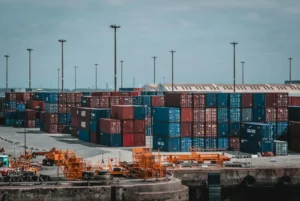In the world of international shipping, the term “bonded shipment” appears frequently.
Understanding what a bonded shipment is can simplify the process of importing and exporting goods, helping to navigate customs regulations smoothly.
AP+’s guide will break down the essential components of bonded shipments, covering the bond process, bonded warehousing, customs brokers and more.
1. Understanding Bonded Shipments
A bonded shipment refers to goods that are held under a customs bond while in transit or stored in a bonded warehouse.
These shipments are intended for international trade and involve specific rules and regulations mandated by customs authorities in the importing country.
Essentially, a bonded shipment allows goods to be transported or stored without the immediate payment of duties and taxes.
Key Terms to Know
– Customs Broker – An agent who assists importers and exporters in clearing goods through customs. They ensure compliance with regulations and facilitate paperwork.
– Bonded Freight – Cargo that is held under a customs bond.
– Customs Bond – A contract between the importer, exporter and customs authorities that guarantees payment of duties and taxes.
– Bonded Warehouse – A facility where bonded goods can be stored until customs clearance is obtained.
– Customs Clearance – The process of passing goods through customs so they can enter or exit a country.
2. The Bond Process
When dealing with bonded shipments, understanding the bond process is crucial for both importers and exporters. The bond process typically involves several steps:
Step 1: Applying for a Customs Bond
Before businesses can engage in bonded shipments, they must apply for a customs bond.
This involves completing a bond application, which requires information about the importer or exporter and the goods involved.
Step 2: Choosing the Right Bond
Importers and exporters have options when it comes to the type of bond required. Common types of customs bonds include:
– Single Entry Bond – Covers a one-time shipment.
– Continuous Bond – Provides coverage for multiple shipments over a specific period, usually one year.
Customs brokers can guide businesses in selecting the right bond type based on their shipping needs.
Step 3: Securing the Bond
Once an application is approved, the importer or exporter must secure the bond, which involves paying a fee.
This fee varies based on the bond amount and the nature of the goods. The bond amount is typically equal to the estimated duties and taxes owed.
Step 4: Goods Under Customs Control
Once the bond is secured, bonded cargo can be shipped to the importing country.
During transit, the cargo is under customs control, meaning it cannot be accessed without authorisation.
Step 5: Customs Clearance
Upon arrival at the **port of entry**, the goods must undergo customs clearance. This involves submitting the necessary paperwork, including the bond documentation.
Customs officials will inspect the shipment and ensure compliance with all customs regulations.
3. The Benefits of Bonded Shipments
Bonded shipments offer numerous advantages for importers and exporters. Here are a few key benefits:
Deferred Payment of Duties and Taxes
The primary advantage of a bonded shipment is that it allows importers to defer payment of duties and taxes until the goods are officially cleared through customs. This helps businesses manage their cash flow better.
Storage Flexibility
If importers are not ready to take possession of their goods immediately, they can store them in a bonded warehouse without incurring customs fees.
This is particularly useful for businesses that require time to prepare for distributing their products.
Compliance with Regulations
For international trade, adhering to customs regulations is crucial. Bonded shipments ensure compliance with customs laws, minimising the risk of penalties or legal issues.
Simplifies Transportation
Using a bonded carrier for transport simplifies logistics. Bonded carriers are authorised to ship goods under bond, ensuring they adhere to customs regulations while in transit.
4. Bonded Warehousing and its Functionality
What is a Bonded Warehouse?
A bonded warehouse is a secured facility where imported goods can be stored without paying duties and taxes until they are ready for distribution.
This type of warehouse operates under the supervision of customs authorities.
How It Works
When goods arrive at the port of entry, they are transported directly to a bonded warehouse.
Here, they are sealed with unique seals and number identifiers, indicating they are under customs control.
Benefits of Bonded Warehousing:
– Cost Management – By delaying duty payments, businesses can better manage their working capital.
– Inventory Control – Importers can monitor their stock levels without incurring additional customs fees.
– Exporting Opportunities – If goods are intended for export, they can be stored in a bonded warehouse until they are shipped out, avoiding duties altogether.
Duration of Storage
Goods can remain in a bonded warehouse for a specified period, usually up to five years, depending on local customs regulations.
After this period, you must either clear the items through customs or forfeit the bond.
5. Customs Clearance and Compliance
Importance of Customs Clearance
Customs clearance is a vital component of the bonded shipment process.
Efficient customs clearance ensures that goods are not delayed during transit or at the port of entry.
Components of Customs Clearance:
– Completing the necessary documentation.
– Providing invoices, packing lists and any required permits or licenses.
– Paying any applicable customs fees, if required.
Role of a Customs Broker
Often, businesses choose to work with a customs broker who can navigate the complexities of customs clearance.
Brokers understand the nuances of customs regulations and can ensure everything is compliant.
6. Challenges and Considerations
While bonded shipments offer many benefits, there are challenges that importers and exporters should consider:
Regulatory Compliance
Failing to comply with customs regulations can lead to penalties and fines. It’s essential to stay informed about the latest customs laws in the importing country.
Time Constraints
The bonded process may take longer than direct shipments due to the necessary paperwork and customs procedures. This needs to be considered when planning shipment timelines.
Risk of Loss or Damage
Since bonded shipments are under customs control, there’s a risk of loss or damage during transit or storage. Obtaining adequate insurance is crucial.
7. What This Means for Importers and Exporters
A bonded shipment can be a valuable tool for importers and exporters looking to minimise upfront costs and simplify the logistics of international shipping.
By understanding the bond process, bonded warehousing, customs clearance protocols and the vital role customs brokers play, businesses can more effectively navigate the complexities of customs regulations.
For anyone involved in international trade, familiarising yourself with bonded shipments not only aids in compliance but also opens the door to smoother shipping experiences and improved cash flow management.








